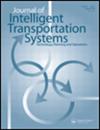预测自动驾驶接管过程中驾驶员表现下降的持续时间
IF 2.8
3区 工程技术
Q3 TRANSPORTATION
Journal of Intelligent Transportation Systems
Pub Date : 2025-03-04
DOI:10.1080/15472450.2024.2307029
引用次数: 0
摘要
本研究进行了模拟器测试,以确定并预测自动驾驶接管过程中驾驶员表现下降的持续时间。车辆轨迹和驾驶员行为数据...本文章由计算机程序翻译,如有差异,请以英文原文为准。
Predicting the duration of reduced driver performance during the automated driving takeover process
This study carried out a simulator test to determine and predict the duration of reduced driver performance during the automated driving takeover process. Vehicle trajectory and driver behavior data were collected in critical and non-critical takeover scenarios. The earth mover’s distance was then adopted to identify the data with the optimal combination of indicators by comparing it to the reference data. The Gaussian mixture model was employed to classify the driving state as either stable or unstable, and the duration of reduced driver performance was derived for each participant based on these results. Subsequently, a generalized linear mixed model was developed to predict the duration of reduced driver performance and examine the impact of various factors on it. Results uncovered a recovery of the reduced driver performance state after drivers took over the automated vehicle. In the non-critical and critical takeover scenarios, the mean duration of reduced driver performance was 17.48 and 27.25 s, respectively. Additionally, the developed model demonstrated good overall prediction accuracy, with the duration of reduced driver performance showing a positive correlation with the lead vehicle’s speed, duration of automated driving, and takeover request lead time. Furthermore, timid drivers exhibited a longer recovery duration than aggressive drivers. These research findings offer valuable insights into understanding the recovery of reduced driver performance during the takeover process, serving as a theoretical foundation for designing safer automated driving systems.
求助全文
通过发布文献求助,成功后即可免费获取论文全文。
去求助
来源期刊
CiteScore
8.80
自引率
19.40%
发文量
51
审稿时长
15 months
期刊介绍:
The Journal of Intelligent Transportation Systems is devoted to scholarly research on the development, planning, management, operation and evaluation of intelligent transportation systems. Intelligent transportation systems are innovative solutions that address contemporary transportation problems. They are characterized by information, dynamic feedback and automation that allow people and goods to move efficiently. They encompass the full scope of information technologies used in transportation, including control, computation and communication, as well as the algorithms, databases, models and human interfaces. The emergence of these technologies as a new pathway for transportation is relatively new.
The Journal of Intelligent Transportation Systems is especially interested in research that leads to improved planning and operation of the transportation system through the application of new technologies. The journal is particularly interested in research that adds to the scientific understanding of the impacts that intelligent transportation systems can have on accessibility, congestion, pollution, safety, security, noise, and energy and resource consumption.
The journal is inter-disciplinary, and accepts work from fields of engineering, economics, planning, policy, business and management, as well as any other disciplines that contribute to the scientific understanding of intelligent transportation systems. The journal is also multi-modal, and accepts work on intelligent transportation for all forms of ground, air and water transportation. Example topics include the role of information systems in transportation, traffic flow and control, vehicle control, routing and scheduling, traveler response to dynamic information, planning for ITS innovations, evaluations of ITS field operational tests, ITS deployment experiences, automated highway systems, vehicle control systems, diffusion of ITS, and tools/software for analysis of ITS.

 求助内容:
求助内容: 应助结果提醒方式:
应助结果提醒方式:


